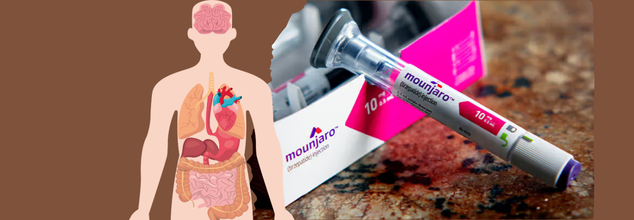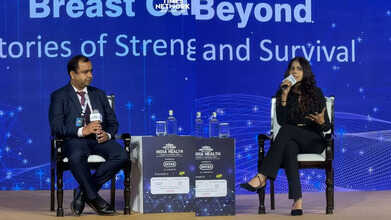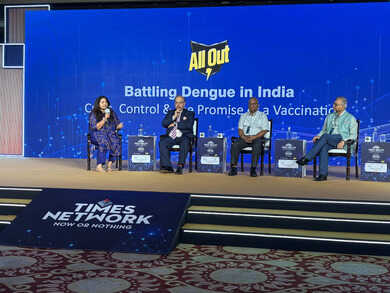- Health Conditions A-Z
- Health & Wellness
- Nutrition
- Fitness
- Health News
- Ayurveda
- Videos
- Medicine A-Z
- Parenting
- Web Stories
Mounjaro For Weight Loss: How It Works, Duration, Side Effects, Cost And More

If you've been doing it all, counting calories, sweating through workouts at the gym and the scale still isn't moving, don't worry. For a lot of people, weight loss has nothing to do with willpower; it's got everything to do with biology. You might have heard the buzz around Mounjaro, perhaps your friend has been talking about it, or you saw it pop up on social media. But what in the world is Mounjaro, and can it actually work for weight loss, even if you don't have diabetes?
For the millions who suffer from obesity, weight loss has long been a Sisyphean task of diets, disillusionment, and defeat. But a new generation of medications, initially developed for diabetes, is rewriting that script. Leading the charge is Mounjaro—a injectable medication that has shown an incredible knack for suppressing appetite, enhancing insulin sensitivity, and encouraging sustained weight loss.
So, what is Mounjaro, anyway? Is it safe? How much does it cost? And is it right for you? Here's the lowdown—supported by science, informed by experts.
What Is Mounjaro?
Mounjaro is a brand name for tirzepatide, an injectable weekly treatment first approved by the U.S. Food and Drug Administration (FDA) for the control of Type 2 diabetes. Nevertheless, its potent effect on body weight has triggered an off-label rush for people without diabetes but with obesity or conditions of metabolic connection.
In contrast to old weight-loss drugs that act on metabolism or suppress appetite as their primary mechanism, Mounjaro acts upon two key hormones: GLP-1 (glucagon-like peptide-1) and GIP (glucose-dependent insulinotropic polypeptide). These control the release of insulin and sensations of fullness. Through the mimicry of their action, Mounjaro decreases hunger and enhances control of blood sugar—two key obstacles in successful weight maintenance.
How Mounjaro Works?
The key to Mounjaro's success is tirzepatide, a dual-acting peptide that acts on receptors in your brain and stomach. When taken, it sets in motion a chain reaction of signals that say to your brain, "You're full," basically cutting back on cravings and overeating.
But that's not all, mounjaro also makes your body more responsive to insulin. In individuals with obesity, insulin resistance is frequent and can render weight loss dishearteningly slow. By enhancing insulin action, Mounjaro makes the body better able to control blood sugar and store less fat.
In a sense, Mounjaro doesn't simply allow you to eat less—it allows your body to use what you eat more efficiently.
Who Can Use Mounjaro for Weight Loss?
Mounjaro is approved by the FDA for individuals with Type 2 diabetes, but physicians can prescribe it off-label to individuals with:
A BMI of 30 or more (considered obese), or
A BMI of 27 or more with one or more weight-related health factors, including high blood pressure or high cholesterol.
Off-label prescribing is legal and widespread. Numerous medicines—from antidepressants to seizure medication—are commonly prescribed for different uses when clinical evidence is available.
But Mounjaro is not appropriate for all. Individuals who have had thyroid cancer, pancreatitis, or gallbladder disease should be careful. Should you be thinking of Mounjaro, complete medical assessment must be done prior to initiation of therapy.
How Much Weight Can You Lose on Mounjaro?
In the largest clinical trial, over 2,500 patients with obesity or overweight were given Mounjaro for 72 weeks (approximately 1.5 years). The patients on the 5 mg dosage lost 15% of their body weight on average. The higher doses had even more weight loss.
Non-diabetic participants also experienced substantial benefits, especially with the addition of lifestyle modifications such as more physical activity and a healthy diet. With regularity and supervision, Mounjaro provides long-term, clinically relevant weight loss—not fleeting outcomes.
How to Use Mounjaro?
Mounjaro is available in a pre-filled, one-time-use injection pen. You administer it once a week, ideally on the same day every week. Injection sites that are commonly used are:
- Abdomen
- Thigh
- Outer upper arm
Physicians usually start at 2.5 mg for 4 weeks, then increase stepwise by 2.5 mg per month to a target dose (in most cases, 10 mg or 15 mg). This stepwise titration minimizes side effects while optimizing efficacy. Take care to change injection sites to avoid irritation and not inject into scarred or bruised skin.
Potential Side Effects of Mounjaro
As is the case with most prescription drugs, Mounjaro can cause side effects—particularly within the first few weeks. The most frequent are gastrointestinal, such as:
- Nausea
- Vomiting
- Diarrhea
- Abdominal discomfort
- Constipation
In some instances, more severe side effects have occurred, including:
- Pancreatitis
- Inflammation of the gallbladder or gallstones
- Low blood sugar (hypoglycemia)
- Kidney issues because of dehydration
- Worsening in eye conditions in individuals with diabetes
- Elevated heart rate
- Reactions at the injection site
Mounjaro also has an FDA boxed warning for a rare risk of thyroid C-cell tumors from rodent studies. Although this has not been established in humans, the warning cautions against use in patients with a personal or family history of medullary thyroid carcinoma (MTC).
How Much Does Mounjaro Cost?
The price for Mounjaro can be quite variable depending on:
- Insurance coverage
- Pharmacy location
- Off-label use status
In the United States, without insurance, Mounjaro can range from $1,000 to $1,300 monthly. Yet, most patients can cut costs with:
- Manufacturer coupons (if qualified)
- Savings programs or discount cards
- Pharmacy benefit coverage (especially for treatment of Type 2 diabetes)
Note: If used off-label for weight loss, some insurance providers might not pay for the medication. Discuss with your provider and pharmacist to learn about affordability options.
Where to Get Mounjaro for Weight Loss?
If you're considering Mounjaro as part of your weight loss strategy, start by speaking with your primary care doctor, endocrinologist, or obesity medicine specialist.
If deemed medically appropriate, they will prescribe it and show you how to use the injection pen. It’s essential to have your lab tests monitored periodically during treatment and to follow dosage adjustments carefully.
Obesity is not a case of willpower. It is a chronic, complex disease related to metabolic, hormonal, and genetic factors. Mounjaro presents a new avenue for the treatment of this disease—especially for those who have not responded to lifestyle modifications alone.
Even so, Mounjaro isn't a panacea. The most ideal outcomes occur when medication is paired with:
- Healthy diet
- Exercise on a regular basis
- Behavioral support or counseling
For individuals with extreme weight issues, it could be the game-changer they've been hoping for.
Mounjaro is changing the face of how healthcare professionals treat weight loss, particularly for individuals with obesity and insulin resistance. Being able to suppress appetite, enhance blood sugar control, and facilitate sustainable weight loss, it's fast becoming one of the most promising weapons in the battle against ongoing metabolic disease.
However, as with any powerful tool, it must be utilized wisely, under professional guidance, and as part of an holistic health plan. If you're curious whether Mounjaro is for you, the best place to start is an open conversation with your doctor.
Times Network Health Summit 2025: Panelists Explore Mental Health And Coping In The Age of Pressure

At a recent Times Network Health Summit, a panel of experts explored the mental health challenges facing India’s youth. With increasing pressures from academics, social media, and career expectations, young people are struggling with stress, anxiety, and emotional instability. To have a deeper conversation on this Panelists Major General Vikram Dev Dogra, Dr. Praveen Gupta, Neurologist, and Actor and Wellness Entrepreneur Pooja Bedi, along with our moderator Kalpana Sharma shared insights and practical strategies for coping in an increasingly demanding world.
The Generation of Overload
Major General Vikram Dev Dogra reflected on the differences between his generation and today’s youth. “Today, young people have access to more information, more opportunities, and more distractions,” he said. While this opens doors, it also brings challenges like mental stress, anxiety, and identity struggles. Constant screen time and social media pressure make balance rare, while decision-making and comparison often fuel stress.
Mental Health vs. Mental Illness
Dr Praveen Gupta emphasized that mental health challenges differ from mental illnesses. While mental health struggles affect many young people, clinical conditions require professional care. He noted that stigma and denial often prevent timely intervention, even among educated individuals. He said, "Open dialogue and early awareness are key to preventing crises and promoting long-term well-being."
Building Inner Connections
Panelists talked about the importance of building deep, meaningful connections. Pooja Bedi explained, “Small connections are good, but inner connections, spending time with friends, joining health camps, or even regular meetups, strengthen your mental health network.” These connections improve resilience and emotional adaptability, sometimes adding years to life.
Hobbies, Exercise, and Resilience For Mental Wellness
Developing hobbies and maintaining routines were identified as crucial tools for mental wellness. “When we grow older, routines can become monotonous. Hobbies give your mind something to look forward to daily,” Bedi said. Physical exercise was described as the single most important tool for brain health. Just 50 minutes of activity a day can improve blood flow, enhance cognitive function, and protect against conditions like dementia. Combined with hobbies and social connections, this creates a strong foundation for mental resilience.
Positivity as a Choice
Happiness, the panel emphasized, is a conscious choice. “Positivity is a mindset,” Bedi explained. “Every day, you choose whether to be happy or not. Spreading positivity starts with personal choice.” She also introduced her initiative, Happy Soul, which offers courses, meditations, and practical tools to enhance mental wellness. Interested individuals can visit poojabedi.com for upcoming sessions focused on meditation, manifestation, and personal growth.
The Role of Awareness and Action For Mental Health
The discussion concluded with a reminder that mental health challenges require both awareness and action. Limiting technology, encouraging open dialogue, growing hobbies, exercising, and making genuine social connections are all practical ways to maintain emotional balance. As Dr. Praveen Gupta noted, the key lies in early detection, honest conversations, and building resilience to adapt to life’s changes.
Times Network India Health Summit 2025: Chhavi Mittal And Dr Samant Gupta Discuss Breast Cancer And Beyond

The Times Network India Health Summit & Awards 2025 hosted a moving session on “Breast Cancer and Beyond: Stories of Strength, Science and Survival.” The conversation brought together actress and breast cancer survivor Chhavi Mittal and Dr. Sumant Gupta, Senior Consultant & Head of Medical Oncology, Hematology, BMT & Director at Metro Cancer Institute, and moderator Pooja Jain, Special Correspondent, Times Network.
Chhavi Mittal's Journey of Taking Charge
Chhavi Mittal opened the session with a candid reflection on her cancer journey. She shared that the first step was not immediate resilience, but acceptance. “Initially, I thought there must be a mistake. Maybe my lifestyle or diet had gone wrong, and if I corrected it, it would go away. But the moment I accepted the diagnosis, I could begin asking the right questions and take charge of my recovery,” she said.
She described herself today as “Chhavi 2.0, a stronger version of myself,” and stressed that every cancer journey is unique. “No two cancers are the same, and no two patients’ reasons are the same. What mattered for me was focusing on lifestyle, routine, and the steps I could control.”
Recurrence, Fear and Moving Forward After Fighting Cancer
Addressing one of the most pressing concerns, "recurrence," Dr. Sumant Gupta explained that about 10–15% of breast cancer patients face the risk of the disease returning. “The first five years are the most critical. After that, the chances reduce significantly, almost to the level of the general population,” he said. But for patients, he noted, living with the fear of recurrence is often harder than the treatment itself. “What helps is a combination of medical vigilance and lifestyle changes like maintaining a healthy weight, exercising regularly, eating a balanced diet, and avoiding alcohol and tobacco. Science today has evolved to preserve not just survival, but also the quality of life.”
Chhavi echoed this sentiment, adding that fear should not overshadow living. “I was fit, disciplined with my diet, I breastfed both my babies, and still, I got cancer. If it recurs, it recurs. I choose not to live under the weight of ‘what if.’ Faith has to be stronger than fear,” she said.
The Role of Caregivers
The discussion also highlighted the silent strength of caregivers. Chhavi shared how her husband supported her journey by giving her space to heal, physically and emotionally. “Sometimes the biggest strength is just allowing your partner to walk their own path and being there quietly,” she said. Dr. Gupta added, “Cancer does not happen to one person alone—it happens to the whole family. Caregivers play an equally important role, from ensuring treatments are followed to supporting the patient’s mental health.”
Shifts in Cancer Treatment
Dr. Gupta explained how oncology has transformed over the decades. “Earlier, treatments were aggressive and destructive. Today, we focus on conservation and holistic care. Surgeries are less invasive, chemotherapy side effects like nausea and hair loss are managed far better, and innovations like scalp cooling and precision drugs have changed patient experience,” he said. He underlined that the focus has shifted from just survival to quality of life, ensuring that patients emerge from treatment with dignity and confidence intact.
A Survivor’s Perspective
Closing the session, Chhavi left the audience with a powerful message. “Breast cancer was the best thing that happened to me. It jolted me out of my comfort zone and pushed me to grow. At one point I stopped comparing myself to who I was before cancer. I began taking one day at a time, and that changed everything. Today, I stand stronger, not in spite of cancer, but because of it.”
Times Network India Health Summit 2025: From Testing Challenges To Long-Term Risks, Experts Decode Battling Dengue

Today at Times Network India Health Summit and Awards 2025, a special panel discussion focused on “Battling Dengue in India: Crisis, Control & the Promise of a Vaccination”. The panel brought together three experts: Dr. Sanjeev Bagai, Chairman of Nephron Clinic, Senior Consultant Paediatrician & Nephrologist, Padma Shri awardee, Dr. K. Madan Gopal, Advisor and Head of Public Health Administration, National Health Systems Resource Centre and Dr Atul Kakar, Chairperson of the department of Internal medicine, Sir Ganga Ram Hospital. Together, they shared insights on how India can fight the growing dengue crisis.
Dengue Testing And Underreporting
Dr. Sanjeev Bagai began by explaining the challenges of testing. He noted that the NS1 antigen test, one of the most common diagnostic tools, does not turn positive until the end of the first day of infection. This often leads to false negatives if testing is done too early, adding to underreporting. He further talked about how many rural cases are never tested or are simply classified as “viral fever,” further skewing national numbers.
From a Seasonal Illness To A Perennial Problem
Dr. Madan Gopal stressed that dengue can no longer be considered a post-monsoon illness alone. “Over the decades, it has evolved from being a seasonal problem to becoming a perennial health threat,” he said, highlighting factors like rapid urbanisation, water stagnation, waste management failures, and climate change. “We need civic, community, and government surveillance working hand in hand to prevent mosquito breeding and control outbreaks,” he added.
Recognising The Dengue Symptoms
Dr Atul Kakar agreed that public awareness of warning symptoms is critical. Severe headaches, pain behind the eyes, back pain, and high-grade fevers should alert both patients and healthcare providers. Dr. Bagai explained that the infection passes through four phases, acute febrile, critical, plateau, and recovery. Importantly, he warned that a fall in fever does not signal recovery. Dr Bagai told us, “Instead, this is often when platelet counts dip, and complications can arise.”
Managing the Patient Burden
On hospital preparedness, Dr. Madan Gopal underlined that 70–80% of dengue cases can be managed at home with proper hydration and monitoring. He emphasised building capacity in both public and private healthcare sectors to identify warning signs early and prevent unnecessary hospital admissions that overwhelm facilities.
Dangers of Self-Medication During Dengue
Dr. Bagai strongly cautioned against relying on home remedies or inappropriate drugs. “Yoga, papaya leaf juice, or herbal concoctions do not cure dengue,” he said. He also warned against taking aspirin, ibuprofen, or antibiotics, as these can worsen bleeding risks and damage the liver or kidneys. The only safe medicine for managing fever, he stressed, is paracetamol along with adequate fluids.
Long Dengue
A critical takeaway from Dr. Bagai was that dengue does not end with the fever. He pointed to new research showing long-term complications, including higher risks of cardiac issues, autoimmune conditions, kidney damage, and neurological problems—sometimes lasting for months after infection. This “long dengue syndrome,” he said, is an emerging challenge that must be factored into health planning.
Dengue Vaccine
When asked about the future of a dengue vaccine, Dr Bagai was cautious. He explained that while early vaccine trials have taken place, the long-term efficacy is poor, with protection falling sharply after four to five years. “Some vaccines work only in the early stages of infection and fail against later serotypes. Others carry the risk of worsening the disease due to the body’s unpredictable immune response,” he said.
Dr Bagai added that dengue’s overlap with other viral exposures, including influenza, COVID-19, and Zika, complicates vaccine development. “The worst thing you can do is give a vaccine that ends up triggering a more severe infection. Some global studies have shown exactly that an increase in hospitalisations among vaccinated individuals,” he warned.
Instead of banking on a vaccine anytime soon, Dr. Bagai stressed that prevention must remain the priority. “The safest and most effective protection is to keep mosquitoes out of your homes, manage water storage, and prevent breeding grounds. Vaccines for dengue are still a far, far distance away,” he said.
Dr. K. Madan Gopal agreed that while research continues, community action, civic surveillance, and strong preventive measures remain India’s best defence in the near term.
The panel concluded that India’s fight against dengue requires:
- Early testing and accurate diagnosis to reduce underreporting.
- Mass public awareness campaigns on prevention and warning signs.
- Stronger civic action to control mosquito breeding.
- Responsible treatment with hydration, paracetamol, and medical supervision.
- Focus on vaccination research, given the presence of four dengue serotypes and risks of repeat infections.
Dr. Bagai summed it up: “Dengue is not just a seasonal fever anymore. It is a national health crisis that demands prevention, awareness, and scientific management, not myths or shortcuts.”
The partners of the Times Network India Health Summit are:
Powered by- INTAS
Co-powered by- Novartis and All out
knowledge partner- MGR University
Supporting partner- FIT INDIA
Strategic alliance partner- OneXtel
Wealth Partner- Nuvama
Outdoor partner- Heights
© 2024 Bennett, Coleman & Company Limited

